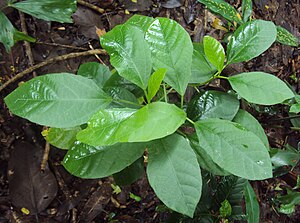Baliospermum solanifolium
| Baliospermum solanifolium | |
|---|---|

| |
| Scientific classification | |
| Kingdom: | Plantae |
| Clade: | Tracheophytes |
| Clade: | Angiosperms |
| Clade: | Eudicots |
| Clade: | Rosids |
| Order: | Malpighiales |
| Family: | Euphorbiaceae |
| Genus: | Baliospermum |
| Species: | B. solanifolium
|
| Binomial name | |
| Baliospermum solanifolium (Burm.) Suresh[1]
| |
| Synonyms[1] | |
| |
Baliospermum solanifolium, synonym Baliospermum montanum, is a plant in the family Euphorbiaceae.[1] It is commonly known as red physic nut, wild castor, wild croton or wild sultan seed.[citation needed] It is a stout undershrub with numerous flowers.
Description
Baliospermum solanifolium is a stout under-shrub 0.9-1.8 m in height with herbaceous branches from the roots. Leaves are simple, sinuate-toothed, upper ones small, lower ones large and sometimes palmately 3-5 lobed. Flowers are numerous, arranged in axillary racemes with male flowers above and a few females below. Fruits are capsules, 8-13 mm long and obovoid. Seeds are ellipsoid smooth and mottled.[2][better source needed]
Distribution
Baliospermum solanifolium is distributed from China to tropical Asia.[1] It is found throughout the sub-Himalayan tracts from Khasi Hills to Kashmir. It is common in Bihar, West Bengal, and Peninsular and Central India.[citation needed]
Phytochemistry
Compounds isolated from this plant include steroids, triterpenoids, diterpenes, glycosides, saponins, alkaloids, and polyphenols.[3] The stems and leaves had the highest total phenolic content, which can be attributed to the existence of tannins in this plant.[3]
References
- ^ 1.0 1.1 1.2 1.3 "Baliospermum solanifolium (Burm.) Suresh". Plants of the World Online. Royal Botanic Gardens, Kew. Retrieved 2024-02-16.
- ^ Warrier, P. K., Nambiar, V. P. K. and Ramankutty, C. 1993-1995. Indian Medicinal Plants. Vol. 1-5. Orient Longman Ltd., Madras.
- ^ 3.0 3.1 Johnson, M; Wesely, Eg; Zahir Hussain, Mi; Selvan, N (2010). "In vivo and in vitro phytochemical and antibacterial efficacy of Baliospermum montanum (Wïlld.) Muell. Arg". Asian Pacific Journal of Tropical Medicine. 3 (11): 894–897. doi:10.1016/S1995-7645(10)60215-5.
Error: "Q15386102" is not a valid Wikidata entity ID.
Error: "Q3595677" is not a valid Wikidata entity ID.